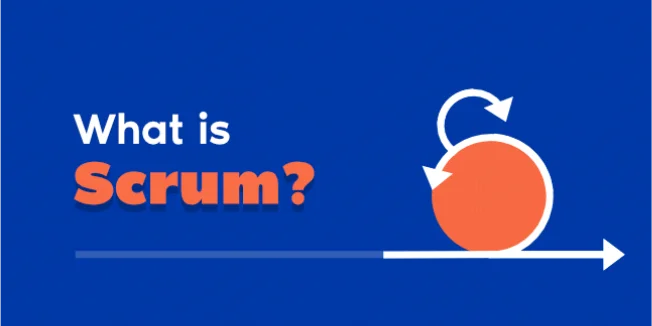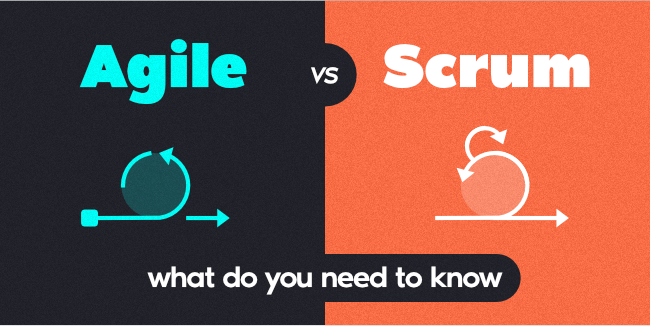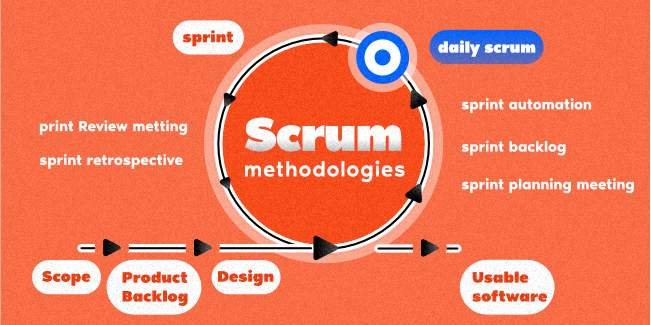Scrum methodology

Scrum is a framework for Agile software development that uses iterative and incremental methods. Scrum is an adaptable, quick, flexible, and the most successful Agile methodology for delivering value to the client throughout the project's development.
The fundamental aim of Scrum is to provide the client with what they want through transparency, team collaboration, and continuous development. Project management in Scrum begins with a broad concept of what needs to be developed, followed by a list of features prioritized (product backlog) by the product owner.
The Difference Between Agile and Scrum
Agile and Scrum are frequently confused since both rely on an iterative process, frequent client contact, and collaborative decision-making. The distinction between Agile and Scrum is that while Agile is a project management approach based on ideas or principles, Scrum is a specialized Agile method used to help manage a project.
There are several distinct differences between Agile and Scrum.

Differences:
- Agile is a philosophy, whereas Scrum is a type of Agile methodology.
- Scrum is divided into smaller timeboxes and items, whereas Agile ensures everything is finished at the end of a project.
- Agile usually involves many cross-functional teams, whereas a Scrum project team has strictly predefined roles such as the Scrum Master and Product Owner.
While Scrum is an Agile technique, it does not always imply Scrum; several distinct methodologies employ an Agile project management approach.
Scrum Process & Methodology
Scrum framework is a logical extension of Agile Methodology. Based on well-defined procedures and roles, the Scrum method must be followed throughout the software development process. It's a flexible approach that encourages you to apply the 12 Agile principles in line with the needs of all team members of the product as determined by all teams.
Scrum is a framework for product development that consists of short, frequent periods known as Sprints. These blocks are often two weeks to four weeks long and are referred to as feedback and reflection. Each Sprint is a distinct entity in itself, meaning that it delivers a complete and independent part of the final product. The motivation behind dividing projects into sprints is to facilitate the entire development process - make it as smooth and effortless as possible.

A project plan is developed by identifying a list of goals/requirements that make up the project plan. The client determines these objectives in terms of a balance between value and cost.
On the one hand, the market demands high-quality, quick delivery at a reasonable price; that is why a company must be very Agile and flexible in product development to maintain short production cycles that may satisfy consumer requirements without compromising quality. It's a simple approach to use and one that many people prefer because of its fast results.
Scrum is most commonly used to develop software, but it may also be applied in other fields, such as sales, marketing, and human resources.
Scrum Team
The fundamental Scrum entity is a small team of people, a Scrum Team. There's only one Scrum Master, one Product Owner, and developers on a Scrum Team. Within a Scrum Team, there are no subteams or hierarchies. It is a group of professionals working toward the same goal.
Scrum teams are cross-functional, meaning they contain members who know to provide value for each Sprint. They're also self-managing.
The Scrum Team should be small enough to remain nimble while still large enough to complete significant work in a Sprint. We've discovered that smaller groups communicate better and are more productive in general. As a result, they should all share the same Product Goal, Product Backlog, and Product Owner.
The whole Scrum Team is responsible for generating high-quality code within each Sprint Increment. The Developers, the Product Owner, and the Scrum Master are all responsible for three distinct accountabilities.
The goal of a Scrum project is for the owner to identify what the product should include (what should be built, what should not be built, and in what order) and any barriers that may get in the way of the software development team's progress. The Scrum Team consists of the following roles:
Development team
Developers are the individuals on the Scrum Team who are dedicated to creating all of a Sprint's usable Increments. nThe Developers' specific talents will vary depending on the area of work; however, they are always responsible for:
- A plan for the Sprint, known as the Sprint Backlog,
- Ensuring high quality by following a Definition of Done standard
- They must update their approach every day as they work toward the Sprint Goal and continue to use it, even if circumstances change.
Product Owner
Is the representative of the project's stakeholders and customers. They're in charge of the company aspect and are responsible for assessing the ROI of a project. They translate the project's vision into words that can be understood by team members, verifying their value in terms of stories to be added to the Product Backlog regularly.
The Product Owner is also responsible for effective Product Backlog management, which entails the following:
- Creating a clear Product Vision and describing it in detail;
- Creating and clearly expressing Product Backlog items;
- Ordering Product Backlog items.
Scrum Master
The role of the Scrum Master is to ensure that everyone follows the methodology's rules and procedures. The Scrum Master reduces project obstacles and works with the Product Owner to maximize the ROI. If a team requires assistance, the Scrum Master's responsibility is to keep Scrum up to date, provide coaching, mentoring, and training.
The Scrum Master is responsible for assisting the Scrum Team in a variety of capacities, including:
- Coaching the team in self-management and cross-functionality
- Increasing the Scrum Team's capacity to focus on creating high-quality increments that comply with the Definition of Done
- Making obstacles to the Scrum Team's progress go away
- Ensure that all Scrum activities are completed and beneficial.
- The Scrum Master cooperate with the Product Owner in several ways, including:
- Understanding and applying the techniques for effective Product Goal definition and Product Backlog management;
- Assist the Scrum Team in comprehending the necessity for clear and concise Product Backlog items.
- Developing analytical product planning for a complicated environment
- We are working collaboratively with stakeholders as requested or required.
The Scrum Master serves the organization in a variety of roles, including:
Leading, training, and coaching the business in adopting Scrum; Planning and advising on Scrum implementation in the company; Supporting workers and stakeholders in applying an empirical approach to complicated work: Removing impediments between stakeholders and Scrum Teams.
Benefits of Scrum Methodology
Scrum has several benefits over other Agile development techniques. It is presently the most widely used and trusted framework in the software industry. The following are some of Scrum's well-known advantages:
Scalability
Scrum procedures may be easily scalable since they are iterative and handled in defined work timeframes. It not only ensures that the features satisfy the user's needs, but it also allows teams to scale the modules in terms of functionality, design, scope, and characteristics without any difficulties.
Everyone is on the same page
The client expresses their expectations of each requirement/project history adds to the value, and the team estimates them. With this knowledge, the Product Owner determines priority. The Product Owner audits that the requirements have been satisfied during sprint demonstrations and provides feedback to the team.
Flexibility
Changes in requirements resulting from customer demands or market developments must be anticipated and dealt with promptly. The approach is meant to adapt to changing needs as a result of complicated projects.
The fast rollout of the product
The client may start using the project's most essential features before it is finished.
High-quality software
This efficiency technique, the need to produce a working version after each round, and the necessity to achieve a higher quality software help create superior software.
Forecast of time and budget
We can estimate when a specific functionality that is still in the backlog will be available by using this approach, as we know the average speed of the team for each Sprint (story points).
Reduction of pitfalls
The ability to do the most important tasks first and understand how quickly the team progresses in the project allows us to address risks ahead of time effectively.
Events in Scrum

Scrum events are used to adapt the process, product, progress, and relationships in some way.
Sprint
The basic unit of work in a Scrum team is the Sprint. It is the crucial distinction between Scrum and other Agile development methods.
Sprint Planning
The Sprint Planning meeting aims to outline what will be done in the upcoming Sprint and how it will be done. This meeting is held at the start of each Sprint and describes how it will deal with the project coming from Product Backlog stages and deadlines.
Daily Scrum
The goal of the Daily Scrum is to evaluate the progress and pattern throughout the Sprint, coordinate activities, and formulate a plan for the next 24 hours. It's a quick meeting that takes place every day throughout the Sprint. Individually, three questions are answered: "What did I do yesterday?" "What am I going on to accomplish today?" What help do I need?"
Sprint Review
The primary purpose of the sprint review is to demonstrate how much work has been completed about the product backlog for future deliveries. The final Sprint is reviewed, and there should already be a clear and visible increase in the product to show to the customer.
Sprint Retrospective
The team analyzes the completed sprint goals, noting the positive and negative aspects to prevent identical mistakes. This process phase is used to identify potential process improvements and develop a strategy for implementing them in Sprint. The sprint review aims to find possible process enhancements and create a plan for implementing them in the upcoming Sprint.
Scrum Artifacts
Scrum artifacts are used to ensure that critical information in decision-making is visible.
Product Backlog (PB)
The product backlog is a list of everything the product needs to satisfy prospective consumers. It's made by the product owner and prioritized according to what's essential for the company. This exercise aims for the product owner to respond with "what should be done" when asked about what should be done.
Sprint Backlog (SB)
The sprint backlog is a subset of the product backlog items chosen by the team for performance during the Sprint in which they will work. The team determines the duration of each Sprint. Everyone who enters the development area may see the development process thanks to the development Scrum board, which displays the sprint backlog on paper.
Increment
The Increment is the total of all tasks, use cases, user stories, and product backlog elements produced in a sprint that will be provided to the end-user in the form of software.
Planning in Scrum
The Sprint Planning Meeting
At the start of each Sprint, the Sprint Planning Meeting is held. The Product Owner, Scrum Master, and all of the Development Team attend the meeting. The goal for that Sprint must be understood and defined by the entire Scrum team (Sprint Objective). To achieve the objective, the development team must create a work plan. This phase should allow you to see if the sprint goal involves a workload according to the duration stipulated for the Sprints (which is 2 to 4 weeks).
The client displays the successful outcome of that Sprint and the product's requirements in this section. Here you must hold a discussion where the development team assesses what portions of the list can be delivered.
Both the Scrum Master and the Product Owner must work together to clarify any requirements' elements. Finally, the development team must explain how it will structure its efforts to meet the Sprint objective.
Conclusion
In this blog post, I have analyzed Scrum from its origin until it is used nowadays. We have seen that the Scrum methodology has been developed based on empirical analysis and validated through experience. Implementing Scrum, we will see how an Agile way of doing projects can help us to improve productivity and quality without losing control of our development process.